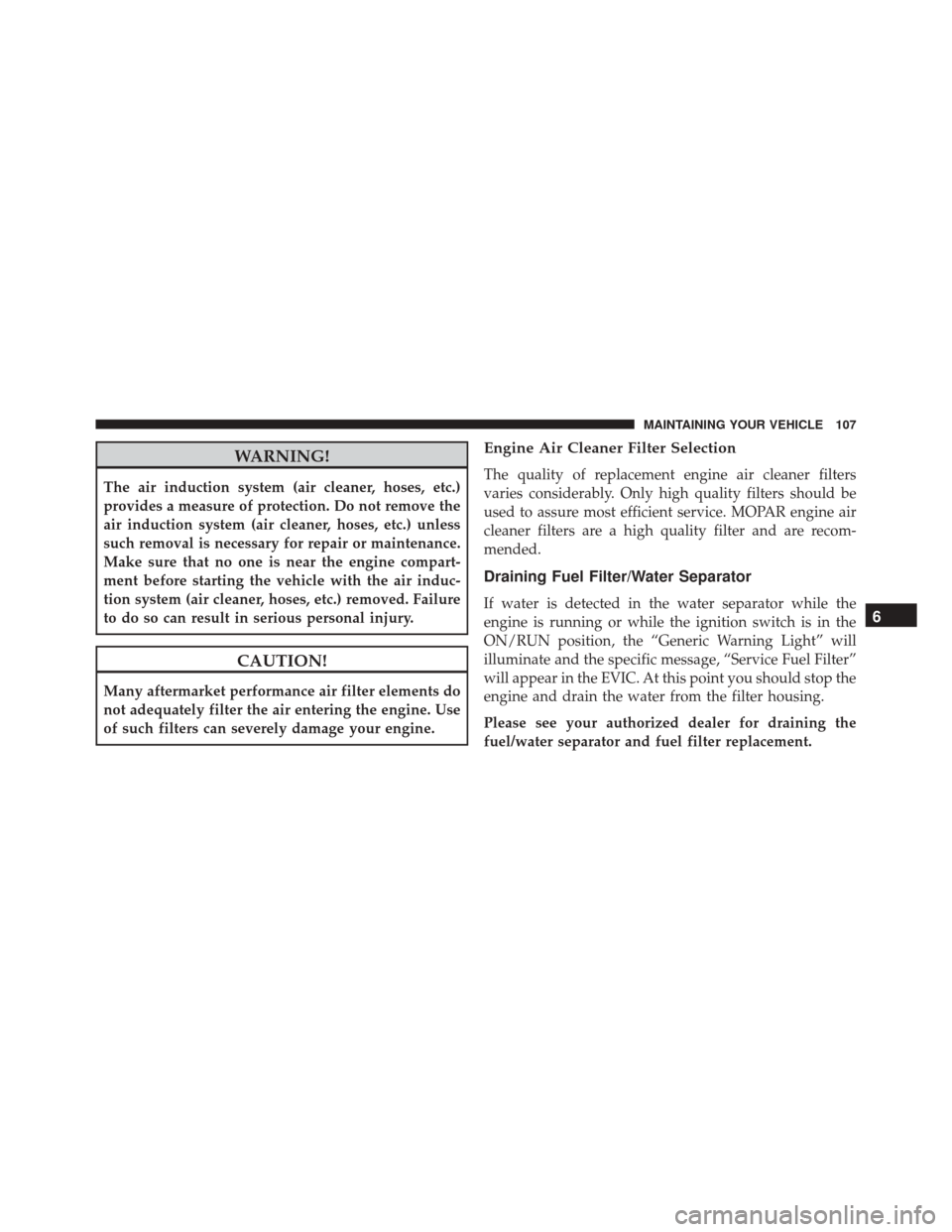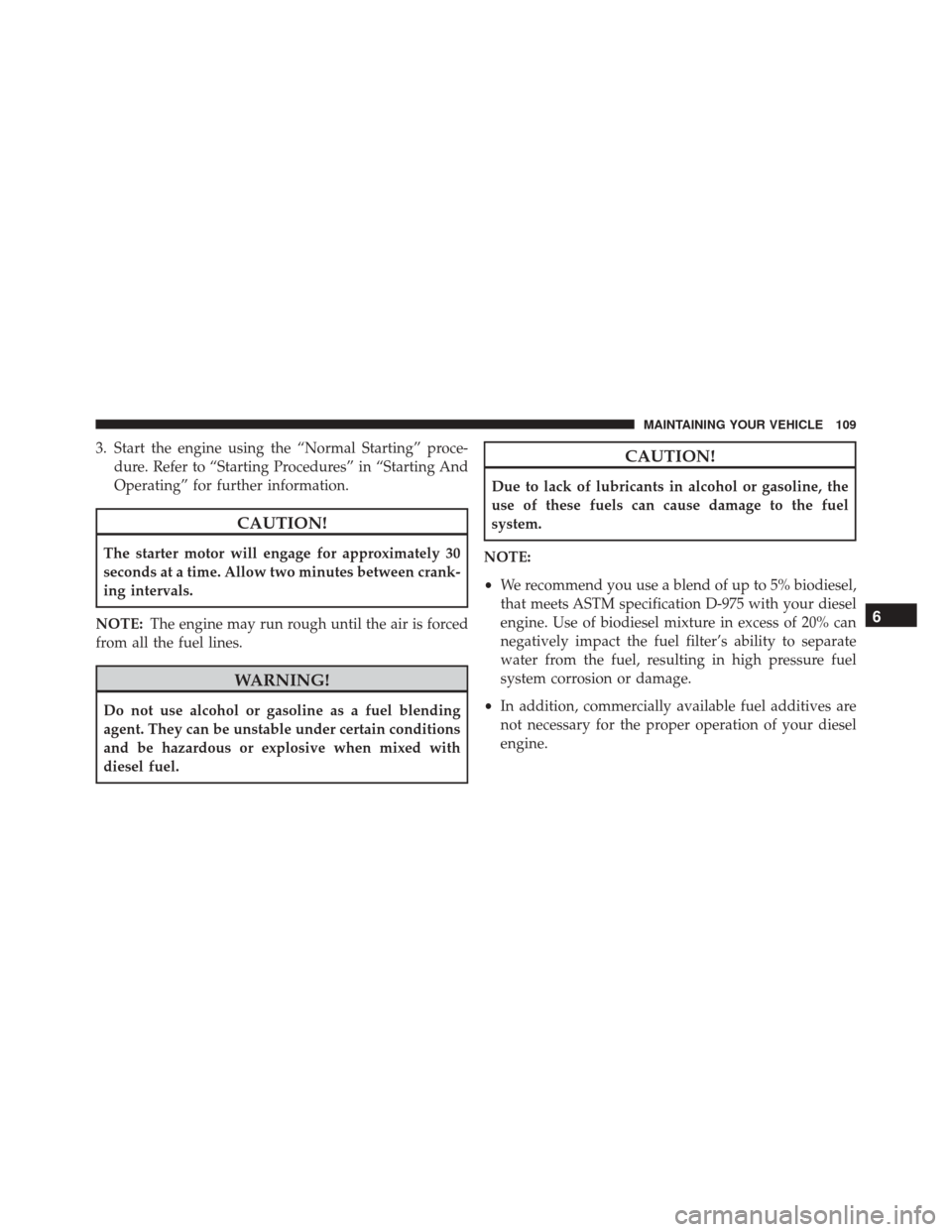Page 85 of 145

NOTE:
•When the fuel nozzle “clicks” or shuts off, the fuel tank
is full.
• Tighten the fuel filler cap until you hear a “clicking”
sound. This is an indication that the fuel filler cap is
properly tightened.
• Make sure that the fuel filler cap is tightened each time
the vehicle is refueled.
WARNING!
A fire may result if fuel is pumped into a portable
container that is on a truck bed. You could be burned.
Always place fuel containers on the ground while
filling.
Avoid Using Contaminated Fuel
Fuel that is contaminated by water or dirt can cause
severe damage to the engine fuel system. Proper main-
tenance of the engine fuel filter and fuel tank is essential.
Refer to “Maintenance Procedures” in “Maintaining Your
Vehicle” for further information.
Bulk Fuel Storage — Diesel Fuel
If you store quantities of fuel, good maintenance of the
stored fuel is also essential. Fuel contaminated with
water will promote the growth of “microbes.” These
microbes form “slime” that will clog the fuel filtration
system and lines. Drain condensation from the supply
tank and change the line filter on a regular basis.
NOTE: When a diesel engine is allowed to run out of
fuel, air is pulled into the fuel system.
5
STARTING AND OPERATING 83
Page 103 of 145
MAINTAINING YOUR VEHICLE
CONTENTS
�ENGINE COMPARTMENT — 3.0L DIESEL . . . .102
� MAINTENANCE PROCEDURES ...........103
▫ Engine Oil ......................... .104
▫ Engine Air Cleaner Filter ................106
▫ Draining Fuel Filter/Water Separator .......107
▫ Fuel Filter Replacement .................108
▫ Priming If The Engine Has Run Out Of Fuel . .108
▫ Intervention Regeneration Strategy —
Message Process Flow ..................110 ▫
Maintenance-Free Batteries ..............110
▫ Cooling System .......................111
▫ Brake System ........................117
▫ Automated Manual Transmission ..........118
� FLUID CAPACITIES ....................119
� FLUIDS, LUBRICANTS AND GENUINE
PARTS ............................. .120
▫ Engine ............................ .120
▫ Chassis ........................... .123
6
Page 108 of 145

which is recommended for all operating temperatures.
This engine oil improves low temperature starting and
vehicle fuel economy.
Materials Added To Engine Oil
The manufacturer strongly recommends against the ad-
dition of any additives (other than leak detection dyes) to
the engine oil. Engine oil is an engineered product and its
performance may be impaired by supplemental addi-
tives.
Engine Oil Filter
Refer to “Fluids, Lubricants, And Genuine Parts” in
“Maintaining Your Vehicle” for further information. The
engine oil filter should be changed at every engine oil
change.
Disposing Of Used Engine Oil And Oil Filters
Care should be taken in disposing of used engine oil and
oil filters from your vehicle. Used oil and oil filters,
indiscriminately discarded, can present a problem to the
environment. Contact your authorized dealer, service
station or governmental agency for advice on how and
where used oil and oil filters can be safely discarded in
your area.
Engine Air Cleaner Filter
Refer to the “Maintenance Schedule” for the proper
maintenance intervals.
CAUTION!
All air entering the engine intake must be filtered.
The abrasive particles in unfiltered air will cause
rapid wear to engine components.
106 MAINTAINING YOUR VEHICLE
Page 109 of 145

WARNING!
The air induction system (air cleaner, hoses, etc.)
provides a measure of protection. Do not remove the
air induction system (air cleaner, hoses, etc.) unless
such removal is necessary for repair or maintenance.
Make sure that no one is near the engine compart-
ment before starting the vehicle with the air induc-
tion system (air cleaner, hoses, etc.) removed. Failure
to do so can result in serious personal injury.
CAUTION!
Many aftermarket performance air filter elements do
not adequately filter the air entering the engine. Use
of such filters can severely damage your engine.
Engine Air Cleaner Filter Selection
The quality of replacement engine air cleaner filters
varies considerably. Only high quality filters should be
used to assure most efficient service. MOPAR engine air
cleaner filters are a high quality filter and are recom-
mended.
Draining Fuel Filter/Water Separator
If water is detected in the water separator while the
engine is running or while the ignition switch is in the
ON/RUN position, the “Generic Warning Light” will
illuminate and the specific message, “Service Fuel Filter”
will appear in the EVIC. At this point you should stop the
engine and drain the water from the filter housing.
Please see your authorized dealer for draining the
fuel/water separator and fuel filter replacement.6
MAINTAINING YOUR VEHICLE 107
Page 111 of 145

3. Start the engine using the “Normal Starting” proce-dure. Refer to “Starting Procedures” in “Starting And
Operating” for further information.
CAUTION!
The starter motor will engage for approximately 30
seconds at a time. Allow two minutes between crank-
ing intervals.
NOTE: The engine may run rough until the air is forced
from all the fuel lines.
WARNING!
Do not use alcohol or gasoline as a fuel blending
agent. They can be unstable under certain conditions
and be hazardous or explosive when mixed with
diesel fuel.
CAUTION!
Due to lack of lubricants in alcohol or gasoline, the
use of these fuels can cause damage to the fuel
system.
NOTE:
• We recommend you use a blend of up to 5% biodiesel,
that meets ASTM specification D-975 with your diesel
engine. Use of biodiesel mixture in excess of 20% can
negatively impact the fuel filter’s ability to separate
water from the fuel, resulting in high pressure fuel
system corrosion or damage.
• In addition, commercially available fuel additives are
not necessary for the proper operation of your diesel
engine.
6
MAINTAINING YOUR VEHICLE 109
Page 129 of 145
Required Maintenance Intervals.
Refer to the maintenance schedules on the following
page for the required maintenance intervals.
At Every Oil Change Interval As Indicated By TheOil Change Indicator System:
•Change oil and filter.
• Rotate the tires. Rotate at the first sign of irregu-
lar wear, even if it occurs before your next
scheduled service.
• Inspect battery and clean and tighten terminals as
required.
At Every Oil Change Interval As Indicated By The
Oil Change Indicator System:
•Inspect brake pads, rotors, hoses and park brake.
• Inspect engine cooling system protection and
hoses.
• Inspect exhaust system.
• Inspect engine air cleaner if using in dusty or
off-road conditions.
7
MAINTENANCE SCHEDULE 127
Page 131 of 145
Mileage or time passed
(whichever comes first)
10,000
20,000
30,000
40,000
50,000
60,000
70,000
80,000
90,000
100,000
110,000
120,000
130,000
140,000
150,000
Or Years: 1 2 3 4 5 6 7 8 9 10 11 12 13 14 15
Or Kilometers:
16,000
32,000
48,000
64,000
80,000
96,000
112,000
128,000
144,000
160,000
176,000
192,000
208,000
224,000
240,000
Check Transmission Actuation
System Oil and Hydraulic
Clutch Operating Oil XX X X X
Additional Maintenance
Replace fuel filter and drain
water from fuel. XX X X X
Replace engine air filter. X X X X X
Replace cabin/air conditioning
filter. XXX X X X X
Replace Brake Fluid every two
years. XXX X X X X
7
MAINTENANCE SCHEDULE 129
Page 138 of 145

Adding Engine Coolant (Antifreeze)............113
Adding Fuel ..............................82
Air Bag Light .............................19
Air Cleaner, Engine (Engine Air Cleaner Filter) . . . .106
Antifreeze (Engine Coolant) ...............112,119
Disposal ..............................115
Anti-Lock Warning Light .....................40
Automated Manual Transmission Fluid Type ........................... .123
Battery ............................. .20, 110
Charging System Light ....................20
Brake Fluid ............................ .123
Brake System ............................117
Fluid Check ...........................117
Master Cylinder ........................117
Warning Light ..........................26
Capacities, Fluid ..........................119 Caps, Filler
Oil (Engine) .......................... .105
Radiator (Coolant Pressure) ................115
Coolant Pressure Cap (Radiator Cap) ...........115
Cooling System ...........................111
Adding Coolant (Antifreeze) ...............113
Coolant Capacity .......................119
Coolant Level ..........................111
Disposal Of Used Coolant .................115
Drain, Flush, And Refill ...................112
Points To Remember .....................116
Pressure Cap ..........................115
Radiator Cap ..........................115
Selection Of Coolant (Antifreeze) ......112,119,120
Cruise Light .......................... .46, 47
Diesel Exhaust Fluid (DEF) ..................120
Diesel Fuel .......................... .76, 120
Diesel Fuel Requirements .................76, 120
136 INDEX